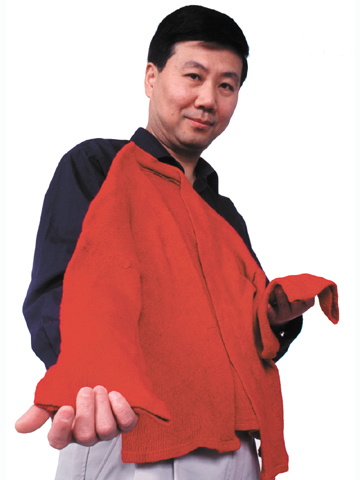| |
|
|

from the issue of May 6, 2004
|

| |
|
|
| |
Textiles from husks may boost value of Nebraska’s top crop

Cornhusk clothing

BY LINDA ULRICH, IANR NEWS SERVICE
Red sweaters abound in Big Red country, but Yiqi Yang’s is unique: It’s made of cornhusks.


 
| | Yiqi Yang, a UNL textile scientist, displays a sweater made of yarn produced from cornhusks. He has developed a process to convert cornhusks into strong textile fibers. The process is still being developed but is efficient and inexpensive. If it's commercialized someday, it could boost the value of Nebraska's leading crop, Yang says. IANR photo.

| |
The UNL textile scientist hopes many people someday will wear clothing made from the husks of Nebraska’s largest crop.

Yang has developed a process to convert the cellulose in cornhusks into textile fibers, which can be made into yarn and woven into fabric. The university is patenting his invention, which he hopes will be commercialized.

“This research is still in the initial stages but it shows us it has great potential to be successful. Based on our very initial work, it will be a good performance textile fiber of the highest quality,” Yang said.

His method uses basic chemistry to extract cellulose fibers and purify them. While still under development, this technique is inexpensive and efficient.

Initially, Yang could only extract short fibers, which are not useful for textile yarn. After figuring out to how make fiber bundles of sufficient size, the fibers were spun into yarn at a USDA research spinning facility in South Carolina. Cellulose, the main constituent of all plant tissues and fibers, is the polymer in cotton, linen and rayon.

Anyone who has been around cornhusks might imagine an itchy fabric but, Yang said, it’s quite the opposite. Since cornhusk fiber is natural, it’s more comfortable than many synthetics. Other pluses: husk fibers are made from a renewable resource and the husk yarn is off-white, which is an attractive neutral color and also easy to dye, Yang said.

“My interest is corn byproducts and I’m interested in using my application to help farmers. It is a natural match to use husks, a material that has limited value, to make clothing and to increase corn’s value for our farmers, our state and the world,” the College of Education and Human Sciences scientist said.

The United States produces about 20 million tons of cornhusks annually. Yang estimates that at least 2 million tons of fibers, worth about $2 billion, could be extracted from these husks each year.

For this Institute of Agriculture and Natural Resources research, Yang used husks from Nebraska cornfields, university test plots and sweet corn husks from local grocery stores. All are excellent for fiber production. Modified combines could easily collect husks while harvesting corn, he said.

The number of husks needed to make a yard of fabric depends on the fabric’s width and weight. About three pounds of cornhusks are needed to make the fiber for an average T-shirt, which weighs about 150 grams.

“The textile industry is a huge market so if we can find an application in textiles, we don’t have to worry about finding a market. Just one application could have a big impact on agriculture,” Yang said.

One of the advantages of corn as a raw material for textiles is that it requires fewer chemicals to grow than cotton or linen plants, which are the primary sources of U.S. fabric fibers.

Using corn for textile fibers as well as food also is a more efficient use of cropland, which could be even more important in countries with limited agricultural land, Yang said.

In addition to clothing, cornhusk fibers could have other uses such as packing and wrapping materials, fiber composite materials and industrial fabrics.

“The husk is the strongest part of the corn plant. Nature did that to protect the seeds. It makes sense to use it for high-strength applications,” he said.

Although Yang is pleased with the fibers and yarn he has produced, he said, “This is still in the conception stage and there is a lot of work waiting for us to develop it as a true textile fiber.”

For the next step in this research, Yang is seeking about $2 million in funding or investment to develop a pilot plant that can produce at least 2,000 pounds of fiber daily from Nebraska’s corn stover.

This Department of Textiles, Clothing and Design research is conducted in cooperation with IANR’s Agricultural Research Division.
GO TO: ISSUE OF MAY 6
NEWS HEADLINES FOR MAY 6
Cornhusk clothing
4 to interview for presidential job
Beadle experts to speak at commencement
Get your pictures taken now for new Ncards
Prairie Burn on East Campus
731707S33285X
|
|
|
|
|
|
|
|